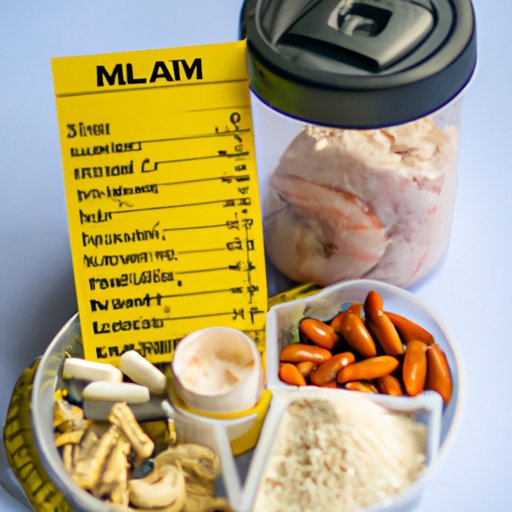Introduction
Bulking is a term used to describe the process of gaining muscle mass and strength through an increase in caloric intake. It’s often done by bodybuilders, powerlifters, and athletes who are looking to build muscle or add size to their frame. In order to successfully bulk, it’s important to understand how many calories you should be eating each day. This article will provide an overview of calorie needs for bulking, as well as tips on creating a meal plan and adding supplements to your diet.

Calculating Your Calorie Needs for Bulking
The first step to calculating your calorie needs for bulking is to determine your Basal Metabolic Rate (BMR). Your BMR is the number of calories your body burns at rest and is determined by factors such as age, sex, height, weight, and activity level. Once you have your BMR calculated, you can then determine your Total Daily Energy Expenditure (TDEE), which takes into account your physical activity level. To calculate your TDEE, multiply your BMR by an activity factor that corresponds to your activity level. For example, if you are moderately active, you would multiply your BMR by 1.55.
Once you have your TDEE calculated, you can then set your calorie intake for bulking. A general rule of thumb is to aim for 10-20% above your TDEE. So if your TDEE is 2,500 calories, you would aim to consume between 2,750 and 3,000 calories per day. Keep in mind that this is just a starting point, and you may need to adjust your calorie intake as needed depending on how your body responds.
Understanding Macronutrients for Bulking
In addition to understanding how many calories you should be consuming each day, it’s also important to understand macronutrient ratios for bulking. Macronutrients are the three main nutrients that provide energy for our bodies: protein, carbohydrates, and fats. Each macronutrient has a specific role and provides different benefits. When bulking, it’s important to focus on consuming enough protein and carbohydrates, while limiting fat intake.
When it comes to macronutrient ratios, a good starting point is to aim for 40% of your total calorie intake from protein, 40% from carbohydrates, and 20% from fats. This can vary depending on individual goals and preferences, but it’s a good starting point. Eating the right types of macronutrients is important for ensuring that you get all the essential nutrients your body needs for optimal health and performance.

Creating a Meal Plan for Bulking
Once you have a general idea of how many calories you need to consume each day and what types of macronutrients you should be eating, it’s time to create a meal plan. Start by planning your meals around your calorie and macro goals. Aim to spread your calories evenly throughout the day, with a focus on getting enough protein with each meal. Protein is essential for building muscle, so make sure you’re getting enough.
In addition to protein, you should also focus on adding healthy sources of carbohydrates and fats to your diet. Carbs are important for providing energy for your workouts, while fats provide essential fatty acids and help to keep you satiated. Try to focus on whole, nutrient-dense foods such as fruits, vegetables, lean meats, whole grains, nuts, and seeds.
Tracking Calories to Ensure You’re Eating Enough
In order to ensure that you’re eating enough to reach your bulking goals, it’s important to track your calories. There are several apps and websites available that make tracking calories easy. Alternatively, you can create your own spreadsheet to track your calories. Whatever method you choose, make sure that you’re tracking your calories and adjusting your intake as needed.
Eating the Right Types of Foods for Bulking
In addition to tracking calories, it’s important to make sure that you’re eating the right types of foods for bulking. Focus on choosing whole, nutrient-dense foods such as fruits, vegetables, lean meats, whole grains, nuts, and seeds. Avoid processed foods as much as possible, as these tend to be high in calories but low in nutrients. Eating the right types of foods will ensure that you’re getting all the essential nutrients your body needs for optimal health and performance.

Adding Supplements to Increase Calories for Bulking
If you’re having trouble reaching your calorie goals, you may want to consider adding supplements to your diet. Popular supplements used for bulking include whey protein, mass gainers, and creatine. These supplements can help to increase your calorie intake without having to eat large amounts of food. However, it’s important to note that supplements should not replace whole foods, and they should only be used in addition to a balanced diet.
Conclusion
Gaining muscle mass and strength through bulking requires a combination of proper nutrition and exercise. In order to successfully bulk, it’s important to understand how many calories you should be eating each day, as well as what types of macronutrients you should be consuming. Calculate your BMR and TDEE to determine your calorie needs, and then create a meal plan that meets those needs. Track your calories and adjust as needed, and make sure you’re eating the right types of foods. Finally, consider adding supplements to your diet to increase your calorie intake if needed. With the right approach, you can successfully bulk and reach your goals.
(Note: Is this article not meeting your expectations? Do you have knowledge or insights to share? Unlock new opportunities and expand your reach by joining our authors team. Click Registration to join us and share your expertise with our readers.)
